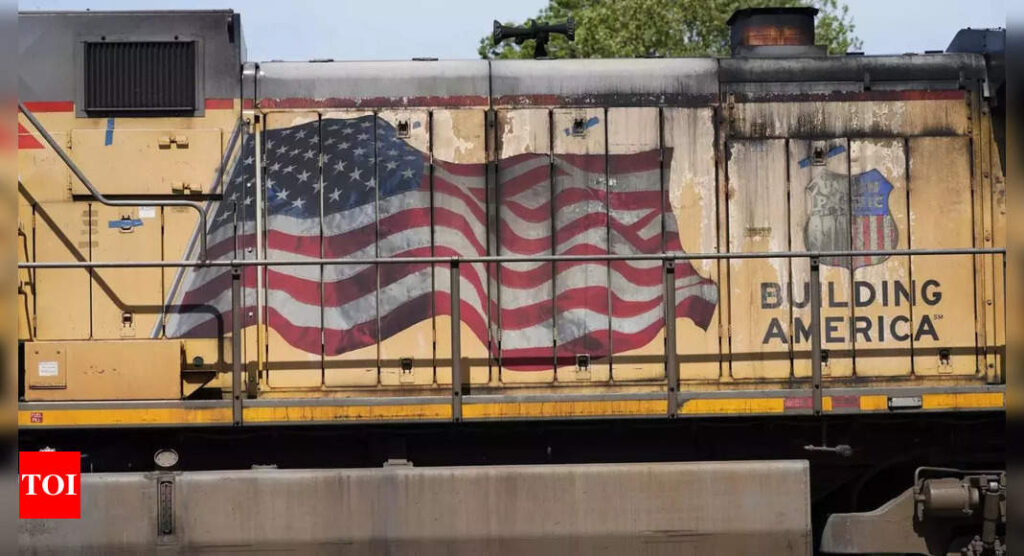[ad_1]
OMAHA: Union Pacific‘s third-quarter profit fell 19% as the railroad hauled fewer shipments and costs remained high, but the average speed of its trains improved 5% as new CEO Jim Vena began to tweak the operations.
The Omaha, Nebraska- based railroad said it earned $1.53 billion, or $2.51 per share, during the quarter, That’s down from $1.9 billion, or $3.05 per share. But the results topped the $2.42 that 12 analysts surveyed by FactSet Research expected.
The number of shipments Union Pacific delivered slipped 3% in the quarter, and while costs improved about 4% they remained elevated at $3.76 billion.
The railroad’s revenue slipped 10% to $5.9 billion because of the lower volume and the lag between when fuel prices increase and when Union Pacific’s fuel surcharge kicks in.
“We faced many challenges in the quarter, including continued inflationary pressures and a drop in carloads,” said Vena, who took the job last month. But the average speed of the railroad’s trains increased to 200 daily miles per car. and other productivity measures also improved during the quarter.
Train speed has continued to improve this month to about 210 daily miles per car today, but Vena said he wants to see that keep getting better to reach the 220s that Union Pacific used to deliver before the pandemic.
“We are aligning the team around our strategy focused on being the best in safety, service, and operational excellence as we drive growth to the railroad,” he said.
Vena said one of his initial moves is to try to push decision making lower down in the operation and eliminate layers of bureaucracy, so it can react more quickly. More cuts are likely but major changes aren’t expected because the railroad already overhauled its operations several years ago.
Vena said he still sees room to improve productivity but he won’t be able to make the same kind of drastic changes he made when he was Union Pacific’s chief operations officer in 2019 and 2020 because the railroad is already more efficient than it was back then.
The railroad will try to use attrition instead of layoffs to reduce the size of its workforce to get more efficient and match current volumes, Vena said.
The railroad said it still expects total volume may decline slightly this year because of the weak consumer demand. So shipments likely won’t exceed the current forecast for flat industrial production.
Union Pacific is one of the nation’s largest railroads and operates more than 30,000 miles of track in 23 western states. Safety has been a key concern for the industry this year ever since a Norfolk Southern train derailed in eastern Ohio in February. UP and the other major railroads are working to improve safety although they already have a record of being the safest way to transport cargo over land.
The Omaha, Nebraska- based railroad said it earned $1.53 billion, or $2.51 per share, during the quarter, That’s down from $1.9 billion, or $3.05 per share. But the results topped the $2.42 that 12 analysts surveyed by FactSet Research expected.
The number of shipments Union Pacific delivered slipped 3% in the quarter, and while costs improved about 4% they remained elevated at $3.76 billion.
The railroad’s revenue slipped 10% to $5.9 billion because of the lower volume and the lag between when fuel prices increase and when Union Pacific’s fuel surcharge kicks in.
“We faced many challenges in the quarter, including continued inflationary pressures and a drop in carloads,” said Vena, who took the job last month. But the average speed of the railroad’s trains increased to 200 daily miles per car. and other productivity measures also improved during the quarter.
Train speed has continued to improve this month to about 210 daily miles per car today, but Vena said he wants to see that keep getting better to reach the 220s that Union Pacific used to deliver before the pandemic.
“We are aligning the team around our strategy focused on being the best in safety, service, and operational excellence as we drive growth to the railroad,” he said.
Vena said one of his initial moves is to try to push decision making lower down in the operation and eliminate layers of bureaucracy, so it can react more quickly. More cuts are likely but major changes aren’t expected because the railroad already overhauled its operations several years ago.
Vena said he still sees room to improve productivity but he won’t be able to make the same kind of drastic changes he made when he was Union Pacific’s chief operations officer in 2019 and 2020 because the railroad is already more efficient than it was back then.
The railroad will try to use attrition instead of layoffs to reduce the size of its workforce to get more efficient and match current volumes, Vena said.
The railroad said it still expects total volume may decline slightly this year because of the weak consumer demand. So shipments likely won’t exceed the current forecast for flat industrial production.
Union Pacific is one of the nation’s largest railroads and operates more than 30,000 miles of track in 23 western states. Safety has been a key concern for the industry this year ever since a Norfolk Southern train derailed in eastern Ohio in February. UP and the other major railroads are working to improve safety although they already have a record of being the safest way to transport cargo over land.
[ad_2]
Source link











More Stories
India’S Growth Forecast: S&P ups India’s FY’24 growth forecast to 6.4% on robust domestic momentum
India to remain fastest-growing major economy, but demand uneven: Poll
Jack Ma: Jack Ma gets back into business with ‘Ma’s Kitchen Food’